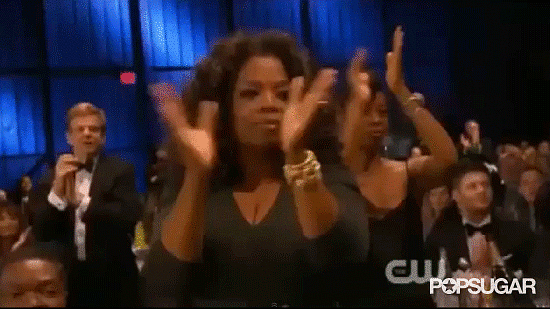Marge wrote about going prizeless, which turned out fine and our participation stayed strong. I was over-the-top happy that we trusted ourselves and our kids enough to encourage reading as a positive expected behavior throughout the summer rather than rewarding it in little bits like a chore. It's important to remember that going prizeless means placing a higher value on your kid patrons' intrinsic motivation, AND on yourselves. Going prizeless means you've placed a high enough value on your well-developed collection, your awesome reader's advisory, your kick-ass programs, and your welcoming environment to know that those mean more to kids than a wooden boat. That's some heavy shizz right there, and I commend Marge and our library director for taking that leap (it's been years in the making. Seriously, please give them a round of applause in GIF form like NOW).
FINE I'll do it.
Anyway. What what we talking about? Right. Summer Reading Game Cards.
The Game Card concept was actually really, really simple. We set it up like a bingo card, and instead of actually playing bingo (which no kid has ever heard of, probably) our genius teen librarian Linda had the revelation: "Why don't they just pick any five out of the nine squares?"
Right?! WHY DON'T THEY.
So that's what we did.
Complete any 5 squares and turn in your sheet= get one sticker to help build the robot.
Complete ALL 9 squares and turn in your sheet= get 2 STICKERS to help build the robot.
Turn in four sheets over the course of the summer to earn a free book!
We had a few different types of activities on each sheet:
--Check out library books (always)
--Read 20+ minutes (there were three spaces on each sheet for this): there was actually a way, then, that kids could choose to complete a sheet without reading at all; the thought behind that is giving them the autonomy to CHOOSE reading. And if they don't read all summer, joke's on them because they get a book!
-- Play/do (with suggestions like "build a fort!" or "dance around the house!"): play is the work of kids. Giving them this option lets them check off things they're already doing, as well as give them new options to use their brains to play (what's that, Bryce kids? You're playing "Puppies with the Golden Hearts" again? Oh yeah, there's a murder mystery to solve? Let me guess, it was the WJR radio host who was behind the scheme all along? Christ. Get over yourselves*)
 |
| Play/Do: play outside! Try: collect leaves on a walk and then make art! (hey look it's me! #nocroppingforever) |
--Write/Draw (these questions ending up being the Stories in Action table... oh right, gotta update that): this encouraged in turns critical thinking and self-expression (and they thought they were playing a game! Mwahahaha!!)
--Tell/Ask (a story, joke, about your day): this encouraged communication as well as narrative skills. (and again! Sneaky librarians!)
--Find it Out: these were simple questions they could find out at the library, on the Internet, or by asking a grownup for help. If they wanted they could consult the Kids Blog at the end of each month to get the real answers (they didn't have to confirm a real answer to check off this box, btw. They just had to try it).
--Play a game at the library: Pick a stick, Mystery Book, or the letter of the week craft.
 |
| This was my favorite week. |
It ended up being such a great summer, with kids coming back to the library with their sheets crossed off, colored, and filled with writing and drawing about what they did. And to me, the strength in this all came down to one thing:
KID POWER.
The kids knew what they needed to do, and they could choose what they did AND how they completed each sheet. Each square gave suggestions rather than requirements (I had a parent ask, "can all of these things happen at the fair? That's where we'll be this week" um, YES). There were nice graphics so even if they were pre-readers they could tell what square was which, or at least make a good guess when asking a grown-up (I saw many a four year old proud as hell to cross off "check out books" without help). And with the addition of the Stories in Action table, they could pretty much do every single thing at the library, hardly relying on their parents at all.
And if you're wondering what percentage of K-5 kids who made it to the "prize" level and received a book chose to keep going post-prize, that answer is 60.75%.
I know.
It was awesome.
*This was an actually game my siblings and I played all.the.time. Names have been changed to protect the innocent [murderer].





No comments:
Post a Comment